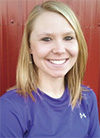My daughter received a book when she was born titled Click, Clack, Moo. Maybe some of you are familiar with it. In the book the cows have developed a most clever form of communication in which they send typewritten notes to “Farmer Brown,” demanding certain amenities such as heated blankets. When they don’t receive the items requested, they lock themselves in the barn and go on strike. I wonder what the cows on our farm would request if they could type? What would yours want?
While cows might not post their requests on the barn door in real life, they still have plenty to tell us if we are willing to listen. As I have grown and developed in my dairy career, I actually find the topic of cow handling and feedback to be the most fascinating topic to study. Milking cows in an automated milking facility (aka robots) has deepened that passion for figuring out exactly what cows are thinking or reacting to in their environment and how we can make life easier for both them and for us as farmers.
When we first moved into the robot barn a few years ago, some days it felt like the information was screaming at me. There was so much of it! Not only did we get a lot of numbers on every cow every milking, but there was the herd info, the feed numbers, even the bills in the mailbox! I would go out into the barn and feel overwhelmed at having to sort out the information but still feel like I wasn’t spending enough time looking at the cows. Suddenly my “cow sense” had been given a great new tool – data. It wasn’t long before I figured out what to do with it: Listen.
One of my favorite things about being a dairywoman is having learned how to go up to a cow and figure out if or what care she needs from me. I look at her eyes; I look at her condition; I watch her walk; I watch to see if she eats with the others and looks well. And now I have also learned to embrace the technology that tells me what I cannot see. I watch her milk temperature if I suspect she is getting an infection; I watch her visits to the robot to make sure she will reach her full potential; and I watch her rumination minutes because she might eat when I’m in bed sleeping.
I learned that “cow sense” can be having sense enough to look at the numbers too. It might be listening to the data from our monthly test, parlors or robots. Maybe it’s listening when the nutritionist tells us he has noticed a pattern or listening to a consultant who has an idea. I think we as dairymen and women know our cows better than most folks know their own families, but even we can use some backup sometimes, right?
So what would the cows on any of our farms want if they could type? Why don’t we just ask them? ![]()

-
Laura Flory
- Dairy Producer
- Dublin, Virginia
- Email Laura Flory




